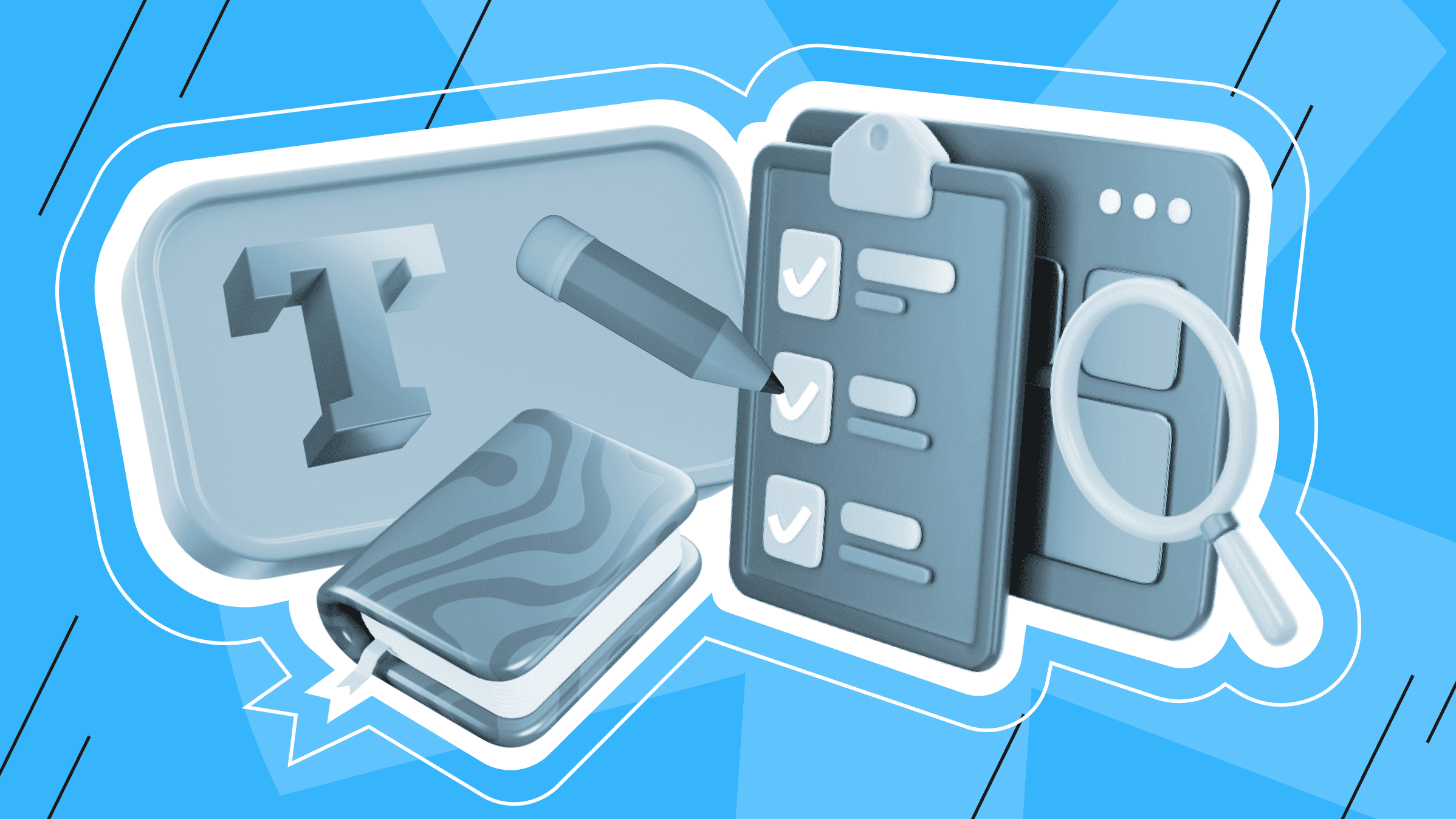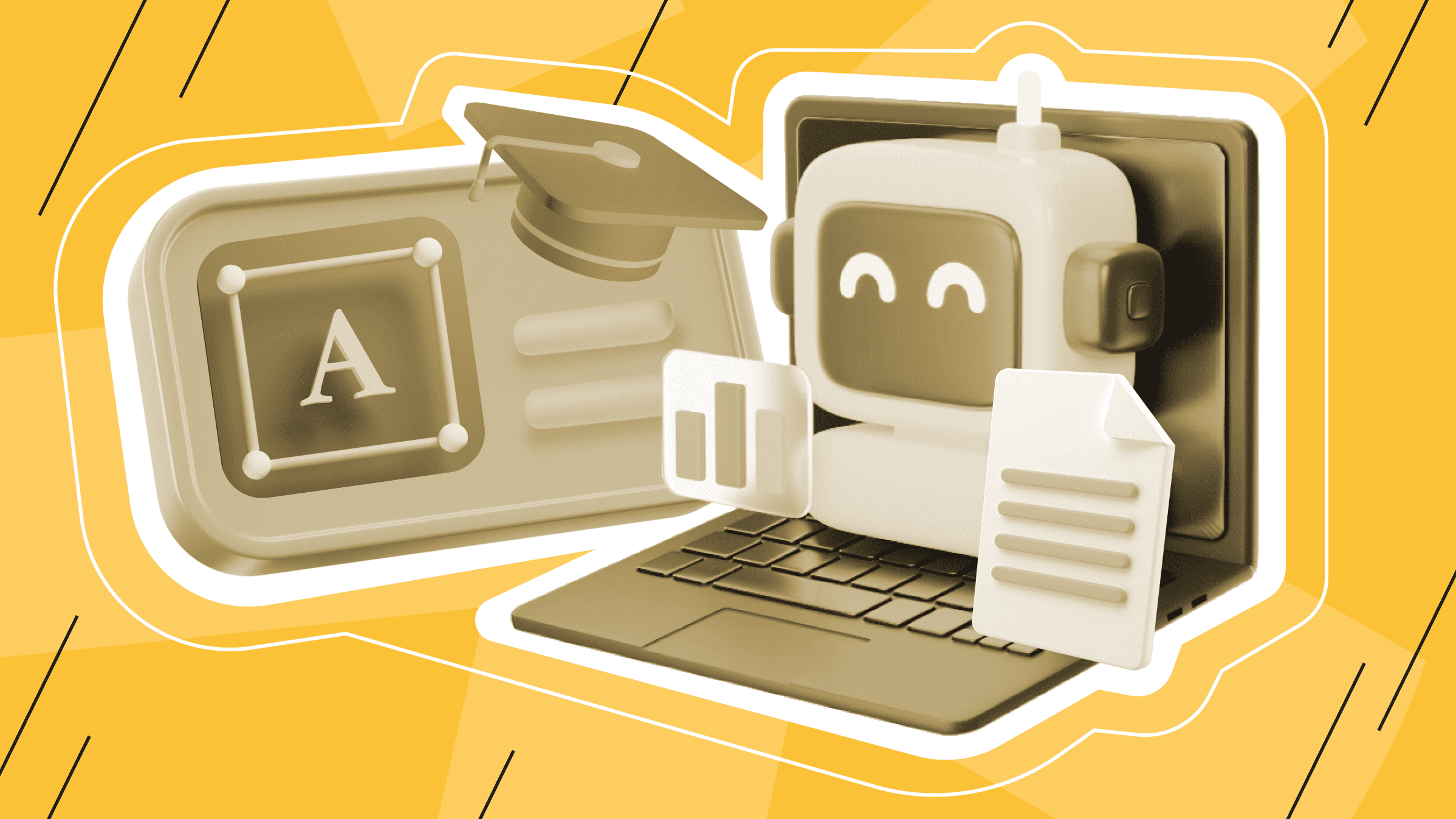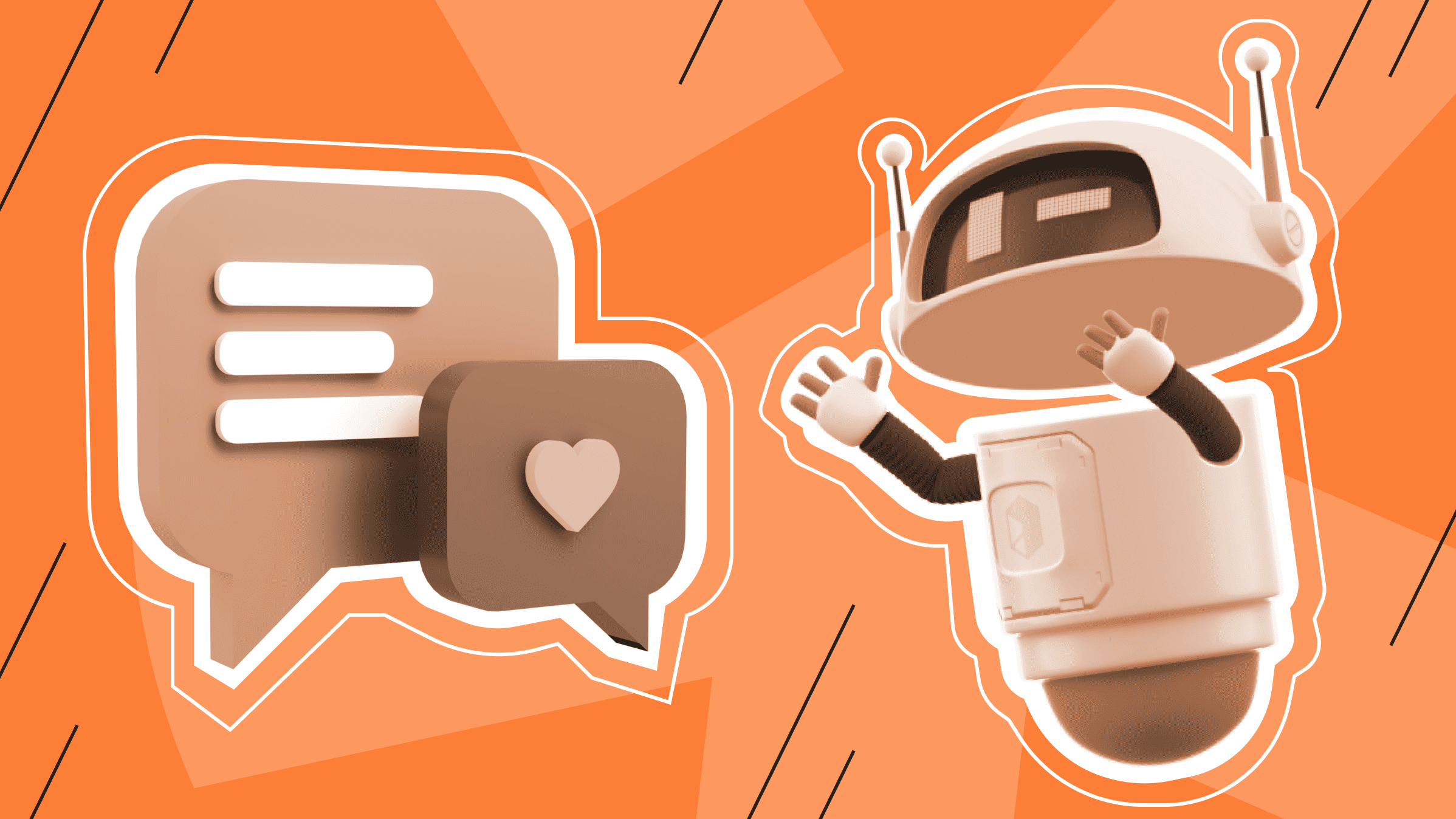
Today, chatbots perform a variety of tasks, from routine tasks such as updating the weather and telling the time to more complex tasks such as advanced medical advice and assisting with questions and customer support. You can deploy a chatbot to discuss your product or create a personal assistant to handle daily tasks and send reminders for upcoming appointments.
You have many options when deploying a chatbot, and one of the most common is integration with social media or messengers, as most people regularly use these.
This article will show you how to create and integrate a chatbot into the most popular messengers.
Understanding Chatbot Basics

The birth of chatbots can be attributed to the middle of the 20th century when the famous mathematician Alan Turing published a seminal paper introducing the concept of the Turing test. This test aimed to determine whether artificial intelligence could demonstrate human-like thinking.
Eliza, developed in 1966, is officially considered the first recognized chatbot. Eliza used artificial intelligence primarily in psychoanalysis and could identify key words in a patient's speech.
The proliferation of chatbots began in the early 21st century, along with the emergence of various messaging platforms. These virtual interlocutors were integrated as contacts, giving users access to operational information. Users sent commands in the form of specific numbers or code words to interact with them and received responses to their queries.
What Is a Chatbot?
A chatbot is a software application designed to mimic human communication, whether a website, messenger, or virtual assistant. With today's users expecting quick responses and personalized interactions, integrating chatbots as a communication channel is becoming vital to the growth of any business.
The simplest chatbots can be programmed to answer common questions, offering an easy way to interact with users. While not all chatbots are equipped with artificial intelligence (AI), many modern chatbots utilize AI techniques such as natural language processing (NLP) to understand user input and provide automated responses. AI-enabled chatbots can learn from users' behavior and previous interactions to predict their actions and provide relevant information.
Chatbots serve various purposes, including answering frequently asked questions, automating tasks, and providing personalized assistance to users in real time. They are used in various industries, including customer service, marketing and sales, to improve user engagement and communication efficiency. How have chatbots become indispensable assistants in today's world?
Types of Chatbots: Rule-Based vs. AI-Driven
Rule-based chatbots, also known as transactional chatbots, operate based on a set of predefined rules and conditional logic. These rules are carefully designed to address specific scenarios or issues the chatbot may encounter. Essentially, these chatbots follow a predefined conversation structure, similar to a flowchart, and determine how to respond to various user requests.
Rule-based chatbots cannot handle questions and tasks outside of the set rules. This means they will be unable to provide meaningful responses in new or unforeseen situations.
Such chatbots do not evolve or improve over time or with user interaction. They consistently apply the same rules without being able to learn from new experiences. As a result, their usefulness is usually limited to scenarios where user interaction is mainly predictable and constrained by rules. Rule-based chatbots are often used to answer frequently asked questions, provide simple instructions, or automate routine processes.
AI chatbots use machine learning and natural language processing (NLP) to provide more complex and adaptable interactions. One of the key differentiators of AI chatbots is their ability to understand the context and intent behind user requests. Instead of relying solely on predefined rules, they use NLP to understand the nuances of language, user credentials, and conversation history.
The hallmark of AI chatbots is their ability to learn and adapt over time. They can tackle a wide variety of questions and tasks, even those they have never encountered before. Their adaptability and learning ability make them well-suited for complex and evolving communication scenarios. How are AI chatbots structured?
Key Components of a Chatbot
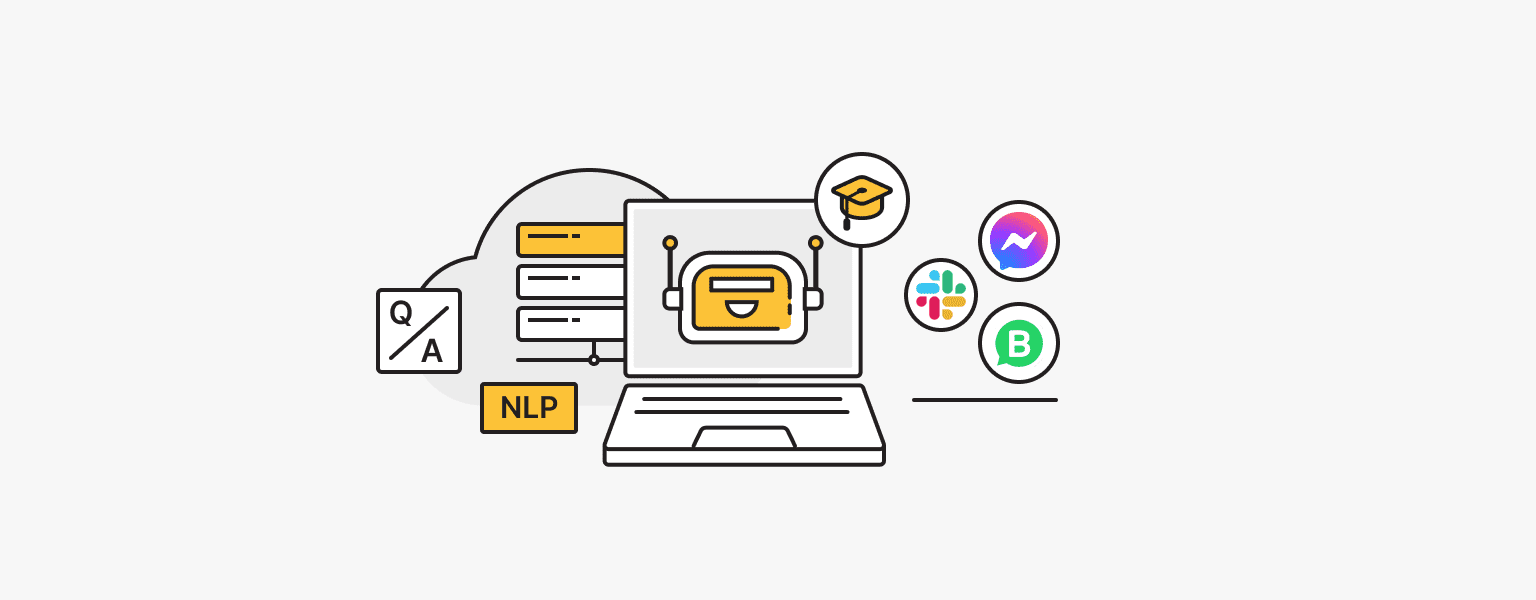
The architecture of a chatbot is the underlying structure, which can change depending on the environment, the area of use, and its type. However, the core components remain the same:
Q&A system
The question and answer (Q&A) system is responsible for answering frequently asked questions from customers. This system includes the following elements:
- Manual training: during the training process, experts in the field compile a list of common user queries and their corresponding answers. This allows the chatbot to find and answer frequently asked questions quickly.
- Automated training: the chatbot is provided with regulatory documents or question-and-answer materials in automated training. The chatbot then independently generates a list of questions and answers based on these documents.
Environment
The environment component contextualizes user messages using Natural Language Processing (NLP) technology. At the core of this architecture is the NLP engine, which interprets user messages and converts them into structured data for processing. It consists of two main elements:
- Intent classifier: maps user queries to specific actions or intentions a chatbot can perform.
- Entity extractor: the entity extractor identifies keywords or entities in the user's query, helping to understand the user's intentions.
The NLP engine can also be extended to include the following components:
- Feedback mechanism: users provide feedback on their interactions with the chatbot, helping it learn from mistakes and improve future interactions.
- Policy training: this system trains the chatbot to create effective conversation flows that improve end-user satisfaction.
External systems
External systems are the user interfaces through which users interact with the chatbot. These systems can include platforms such as Facebook Messenger, WhatsApp Business, Slack, a website or mobile applications.
Node server/traffic server
The node server or traffic server manages user traffic requests and routes them to the appropriate components of the chatbot architecture. It also provides routing of responses from internal components back to external systems.
Custom integrations
Custom integrations allow a chatbot to connect to existing back-end systems such as customer relationship management (CRM) systems, databases, payment applications, calendars, and other tools. These integrations extend the chatbot's capabilities by accessing and utilizing data from various sources.
Benefits of Integrating Chatbots in Messaging Apps

According to current statistics, the number of monthly active users of messengers exceeds 5 billion people. Hence, using chatbots in messengers opens up unlimited opportunities for business development and audience engagement.
One of the main advantages of chatbots in messengers is the ability to interact with customers in real time. With the help of chatbots, companies can respond to customer queries around the clock, which increases customer satisfaction and loyalty.
Chatbots can also handle a wide range of customer service-related tasks. They can answer frequently asked questions, assist with troubleshooting, and provide instructions for various procedures. In this way, chatbots free up employees, allowing them to focus on more complex and highly specialized tasks that require human input.
Chatbots also make it possible to automate routine tasks and queries and handle many customer inquiries without a proportional increase in operational costs.
Modern chatbots are equipped with machine learning algorithms to analyze customer data. This personalization allows companies to tailor their marketing campaigns to meet customer needs, improve their products and services, or identify areas for improvement.
Chatbots can be programmed to communicate in multiple languages, making them invaluable for companies operating in different markets. This capability allows companies to expand their reach and increase their competitiveness in the global marketplace.
Setting Up a Chatbot for Telegram
Telegram is one of the world's top three most downloaded apps and has 700 million monthly active users. The number of new users is planned to exceed 1 billion by 2024.
Telegram has gained an exceptionally loyal audience in today's increasingly privacy-conscious world. The focus on privacy and security has led to the global adoption of the platform, which presents a remarkable opportunity for businesses to engage customers in a safe and secure environment.
Overview of Telegram Bots
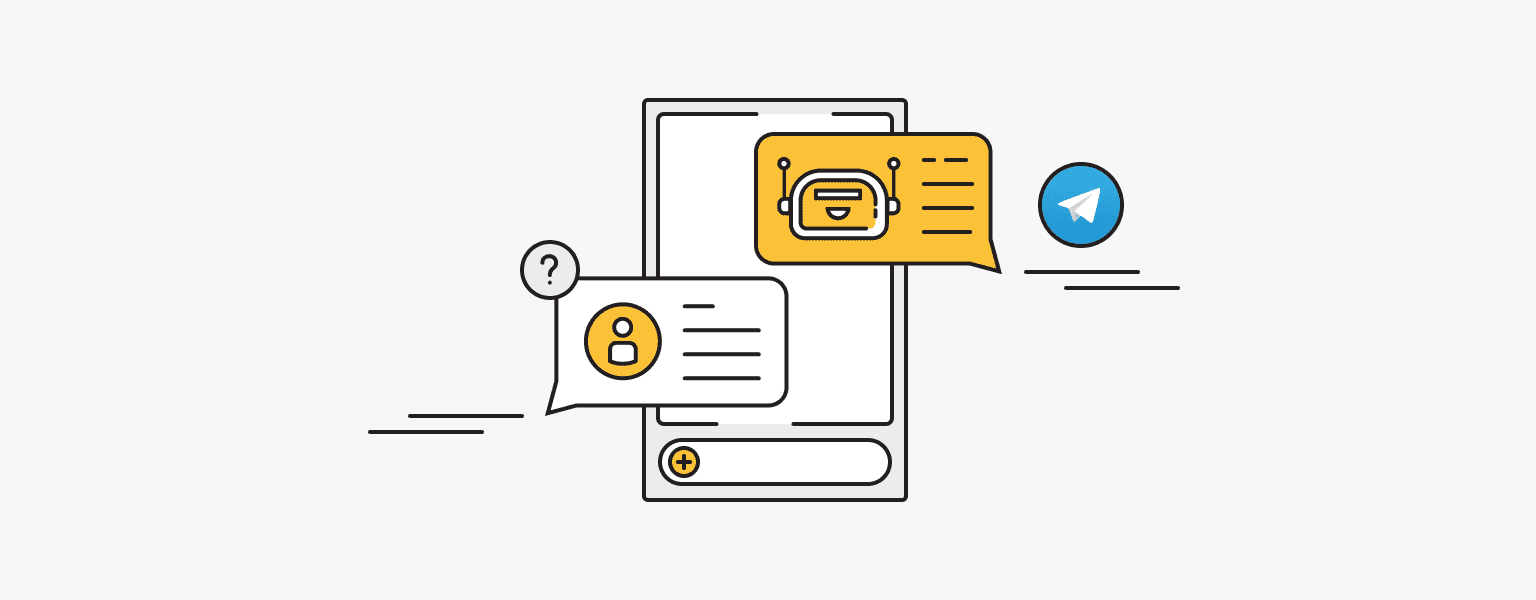
A Telegram bot is a program that mimics an average conversation partner while providing additional functionality. It can autonomously perform predefined tasks without requiring user intervention.
Telegram stores all data, including chats and bots, in encrypted form on its cloud servers. External backups of Telegram data are generally not required, as users can access their personal settings seamlessly across platforms. However, sensitive data and external commands accessed by the bot may reside outside the cloud, for example, on the company's local servers in its own databases.
Telegram's chatbots are primarily built around a conversational flow consisting of three main elements:
- Trigger: Determines when the chatbot should start a conversation.
- Action: Determines the chatbot's tasks, such as sending messages.
- Condition: Performs logical checks in "if this, then that" scenarios.
A Telegram bot can perform almost all tasks that a conversation partner performs It can automatically or on demand send various types of information, including text messages, images, videos, and files of any format.
One of the features of a Telegram bot is its ability to execute commands in Telegram chat. These commands trigger specific actions or request information. For example, upon receiving the "/help" command, the bot will offer a list of available commands in the chat. This list may include commands such as:
/status
/stop
/temperature
/last alarm
Regular Telegram bots are public and available to any user. However, access to Telegram bots can be restricted to specific users by setting up a separate communication channel with the bot. This channel acts as a "private" group with the bot, including you, your approved users, and the bot itself. Thus, the Telegram bot will only be available to the users you control.
Telegram bots are easily recognizable by the suffix "bot" in their names. For example, "@weatherbot", @my_test_bot". Public bots can be found using Telegram's user search function or third-party directories online. Private bots require an invitation to a private group from the bot administrator.
Examples of Telegram Bots
- Skeddy (@SkeddyBot)
Skeddy is a handy reminder bot you can interact with in your Telegram chat. It's very easy to use- just enter the reminder text, specify the date and time, and you'll receive a notification in Telegram chat when the scheduled time comes.
- Botfather (@botfather)
Botfather, the official Telegram bot, allows users to create their own Telegram bots.
- IFTTT (@IFTTT)
IFTTT, or IfThisThenThat, specializes in connecting different web services and automating the user experience. This bot for Telegram easily connects your group or channel to 360 external services, including platforms like Instagram and Twitter.
- File Converter (@newfileconverterbot)
File Converter is a versatile tool that can convert files of almost any format.
- DropMail.me (@DropMailBot)
DropMail offers disposable email addresses. These addresses can receive confirmation or activation emails for various registration processes.
- AirTrack (@airtrack_bot)
AirTrack makes it easy to search for flights right in Telegram. Simply enter your departure airport, destination, and flight dates, and AirTrack will offer you the most affordable flight options.
Using BotFather to Create a New Bot
BotFather is the central tool for creating bots in Telegram. This tool will walk you through the necessary steps to install a bot and customize its functionality to suit your needs.
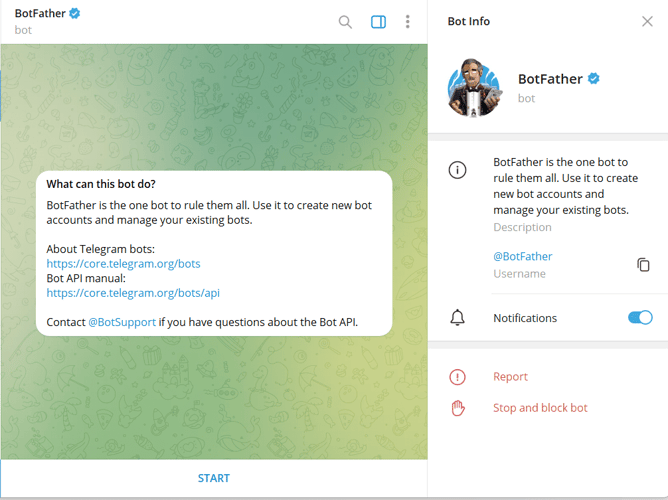
Start by installing the Telegram app on the device of your choice. The Telegram app for mobile devices can be found in popular app shops such as Google Play Store or Apple App Store. You can visit the official Telegram website at https://telegram.org/ and find the appropriate download link for other devices.
- To create a bot, click START and select the /newbot command. You can also type a message with the text /newbot.
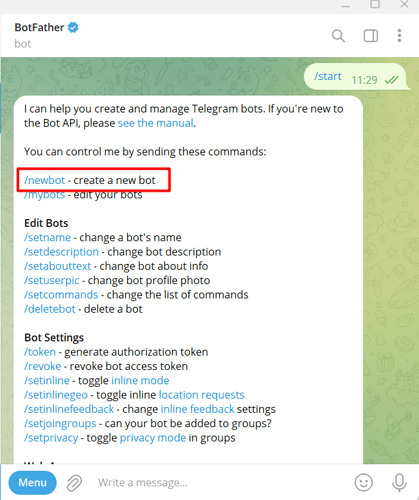
- After naming your bot, you will receive an HTTP API access token. You can personalize your bot, for example, change the name, set a picture, or add a description by selecting the /mybots command.
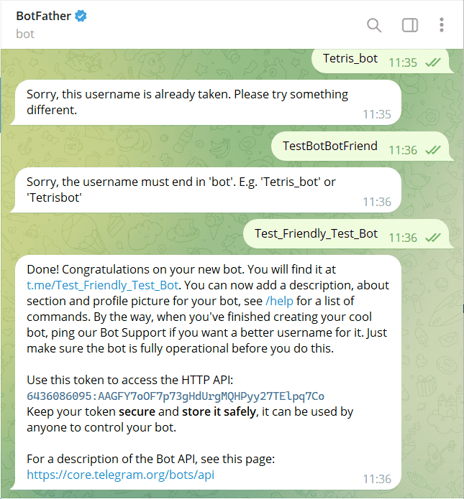
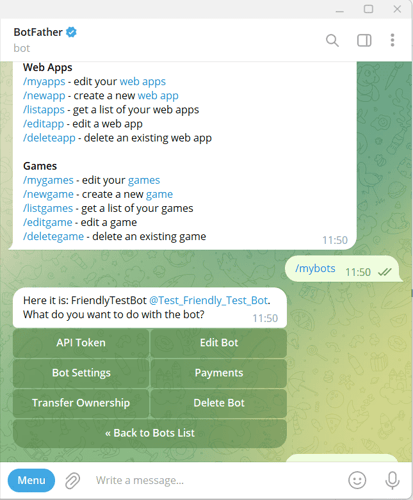
Integrating with the Telegram API
You can use DialogFlow to train and customise your bot, as well as integrate it with the Telegram API.
To start working with Dialogflow, you will need a Google account and an HTTP API access token. You can copy this token from the BotFather menu.
On the left menu, click Integrations, select Telegram, and enter your token.
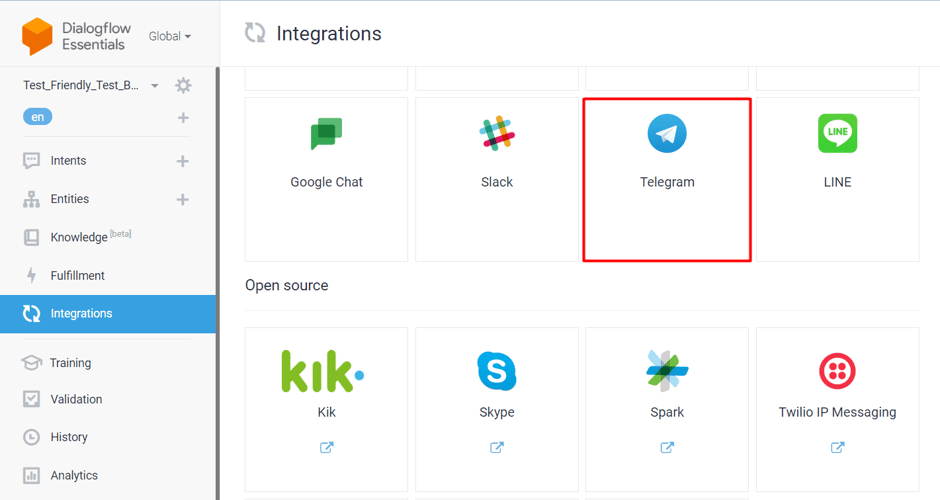
Using the SmallTalk tool, you can train your bot with phrases that it will use to answer questions or react to users.
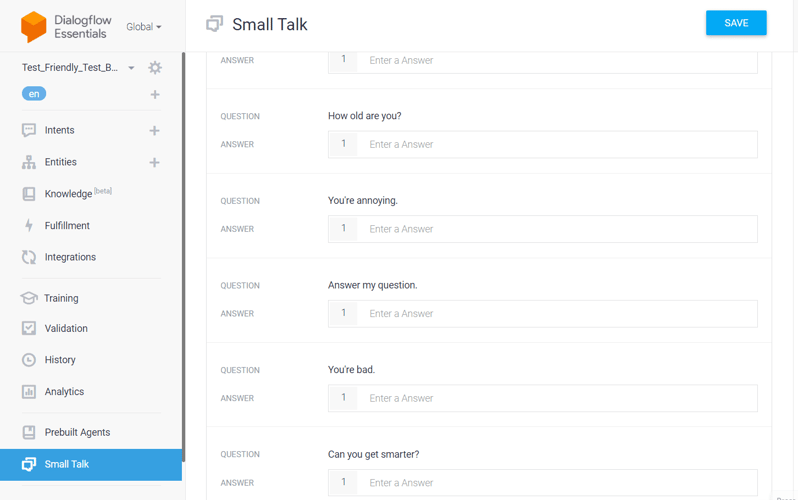
You can also set up the Intent feature so your bot can provide users with information based on keywords or phrases. For example, your chatbot can provide a link to a weather forecast website in response to user queries such as "Rain," "Weather," "Air temperature," "Summer temperature," etc. The more key phrases or questions you create, the more accurate your chatbot's answers will be.
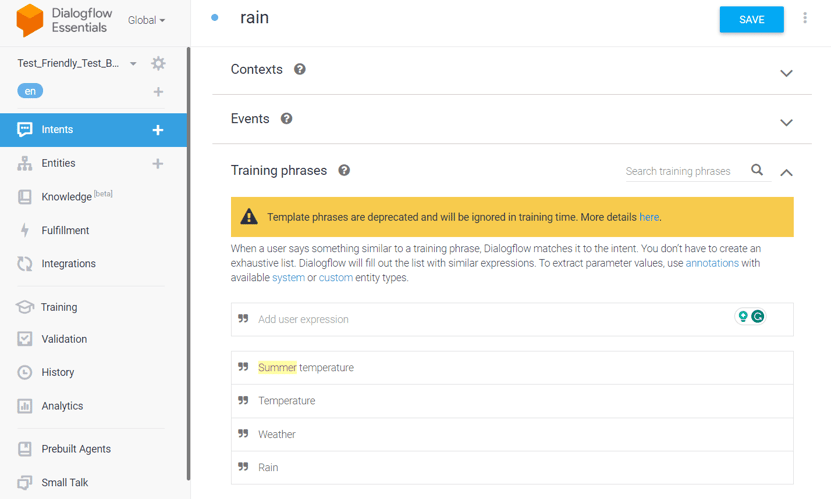
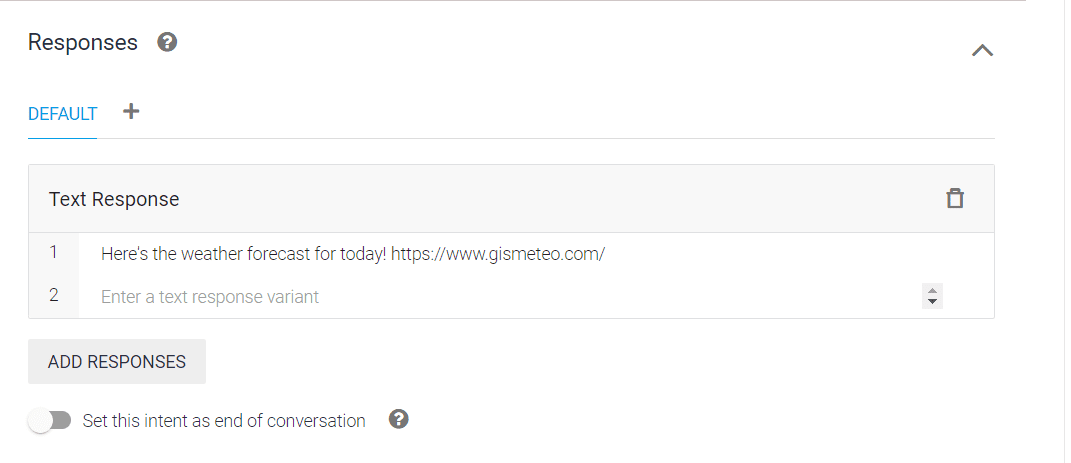
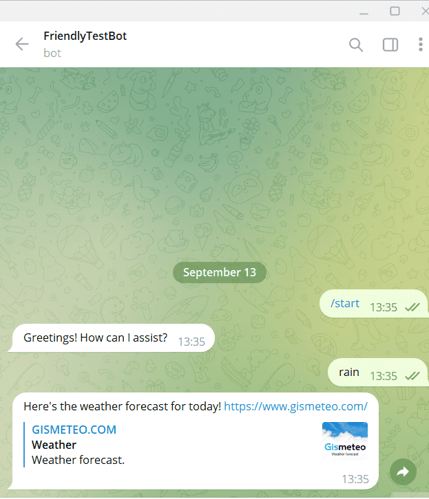
Telegram provides detailed instructions on how to set up, create, integrate and extend the functionality of your bot, which will be useful for both beginners and experienced developers.
Building a Chatbot for WhatsApp
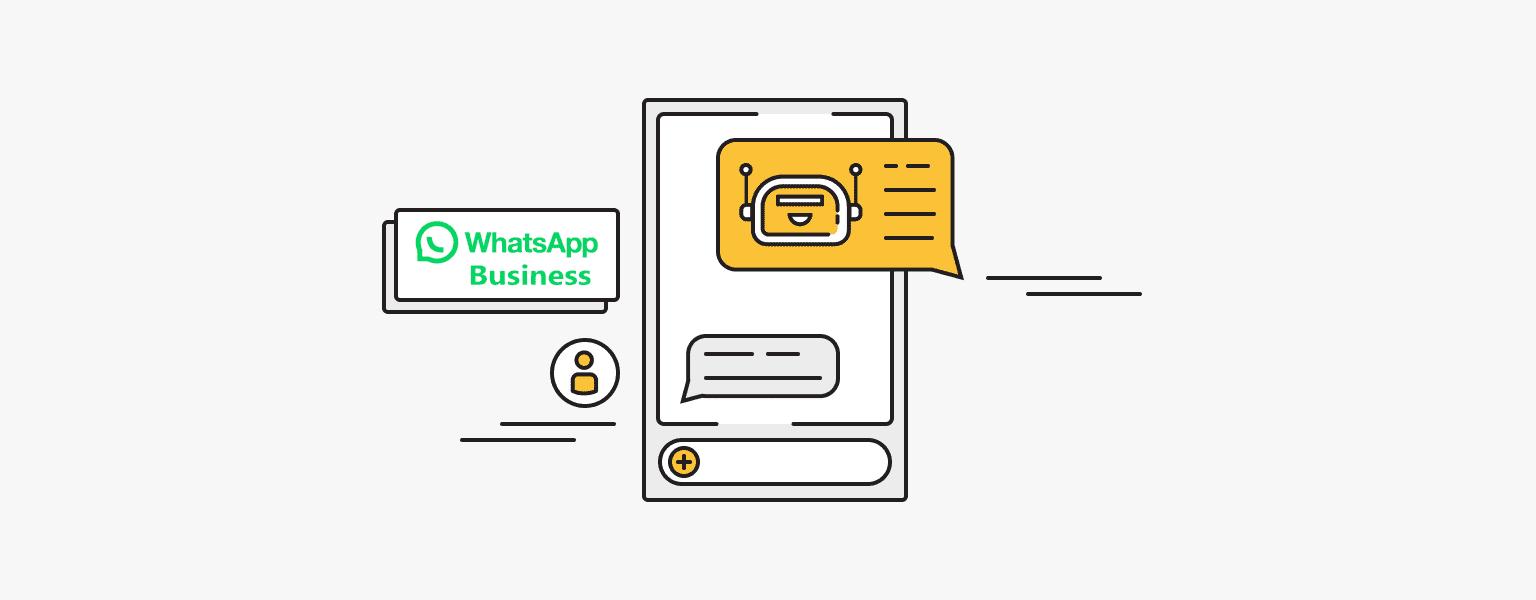
A WhatsApp bot offers your potential customers an automated real-time conversation directly within the messaging app. WhatsApp chatbots can come in two primary forms: rule-based, which follows decision trees for structured interaction, or NLP-based, which uses natural language processing to create a more human-like conversation.
However, it's important to note that you must apply for and be authorized to integrate with the WhatsApp Business API to deploy a bot on WhatsApp.
WhatsApp Business API: An Overview
WhatsApp Business API is a powerful tool that allows businesses to interact with their customers at scale on the WhatsApp platform. Businesses can use pre-approved message templates to send their customers notifications, updates, and reminders. These templates allow them to maintain high quality and standardized messaging.
Businesses can also implement chatbots and automation to handle common customer queries and streamline processes. This reduces response times and improves efficiency. WhatsApp Business API prioritizes data security and privacy by protecting customer information. End-to-end encryption is one of the core aspects of WhatsApp.
WhatsApp Business API can be integrated with CRM systems, customer support tools, and other business applications to ensure smooth operations. Companies need to have an official WhatsApp business account to use the API, which is different from personal accounts. In some regions, companies can integrate payment features into WhatsApp for transactions and purchases.
Setting Up a WhatsApp Business Profile
First, it's important to note that connecting to the WhatsApp Business API on your own is impossible. You will need the services of an intermediary company, which can be categorized into two categories:
- ISV (Independent Software Vendor): These are software providers certified to work with WhatsApp business solutions.
- BSP (Business Solution Provider): The complete list of business solution providers can be found on the official website.
After selecting a suitable company, you need to initiate contact with them. You will be required to fill out the application form, verify the company on Facebook, confirm the phone number, and then you can proceed. You must also register HSM (Highly Structured Messages) message templates to initiate customer contact.
To verify your company, you need to follow the steps below:
- Go to the Company Information section in Facebook Business Manager.
- Make sure the status in the Company Confirmation field is marked as verified. If the status is not verified, go to the "Security Center" section.
- You must fill out several forms containing your company information during the verification process. In addition, you will need to upload documents that prove your company's activities.
- After submitting the required forms and documents, you can complete the verification process in one of two ways:
- Receiving a phone call to your company's registered phone number.
- Receiving a verification code via email sent to the email address associated with your company. Ensuring the email domain is the same as the company domain listed on the application form is essential.
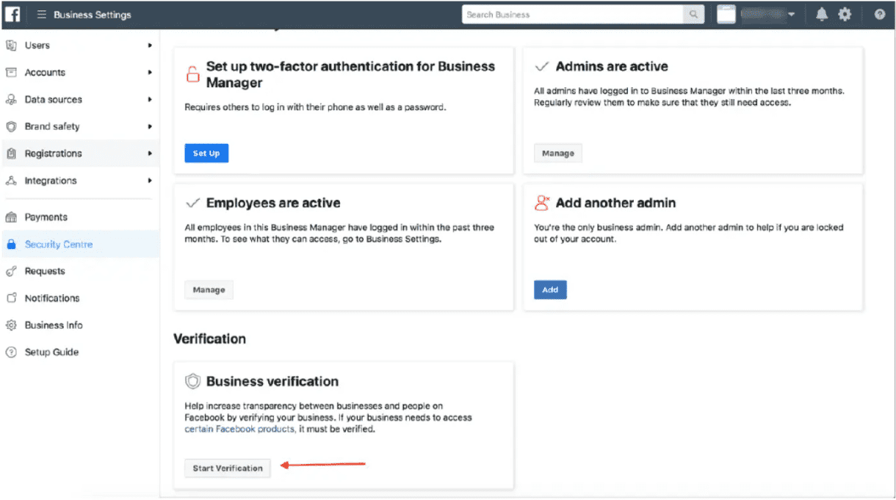
Integrating a Chatbot with WhatsApp

Using third-party services is the easiest way to create a chatbot in WhatsApp. These include services such as Chat2Desk, Botmother, TextBack, Chat Helpdesk, Twilio, IntellectDialog, and others.
These services come with ready-made basic settings; you only have to finalize the scripts and chatbot interaction. When choosing a service, it is important to ensure it provides access to WhatsApp Business API.
Another advantage of these platforms is the ability to integrate. Data from chatbot interactions, such as orders, can be automatically transferred to CRM systems or Google Sheets through integration. This eliminates the need for managers to enter data manually and minimizes the risk of data loss.
Some services provide out-of-the-box integration modules, but you may need the help of a developer or connector to set up the integration process.
Choosing a platform to integrate chatbots with WhatsApp Business API is a critical decision that depends on various factors that align with your business priorities and service model. These platforms offer a range of services such as:
- 24/7 customer support: Providing 24/7 customer support through your chatbot is critical to improving user satisfaction.
- Optimized bot-to-human handover for handling complex queries: A smooth transition from automated bot-to-human interaction to an agent for complex queries ensures a seamless customer experience.
- Multi-language support: The ability to communicate with customers in their preferred languages is essential to extend your reach.
- Conversion Analytics: Robust analytics tools provide insights into user behavior, which helps to improve the chatbot's performance and increase conversions.
Since WhatsApp chatbot capabilities constantly evolve, identifying a well-designed conversation flow is paramount. This flow will determine what users get when interacting with the bot and how it handles requests outside its expertise.
You must think through possible user questions and formulate answers to create this flow. The chatbot development provider you choose will use this flow as a blueprint for development.
Testing is crucial to ensure your WhatsApp chatbot is effective in customer service. Conduct thorough testing by asking the bot various expected and unexpected questions to gauge its responses. This process will help identify and fix any problems before bringing the bot to the market.
You can use the following business bot platforms for WhatsApp to integrate your chatbot:
- Twilio: Twilio's WhatsApp integration includes a sandbox for rapid prototyping, offering instant access to WhatsApp without waiting for approval. Key features include a REST API for messaging, a programmable SMS API for secure messaging, support for various programming languages, real-time status tracking, and the ability to send multimedia files.
- Vonage: Vonage is a reputable WhatsApp Business chatbot service provider. It lets you send notifications, customer data, and essential service messages via WhatsApp. Vonage's API makes hosting, scaling, and managing WhatsApp Business easy. Features include easy setup, integration with apps such as Salesforce Service Cloud, end-to-end chat security, real-time message delivery feedback, and support for rich media messages.
Please note that WhatsApp Business API integration requires adherence to WhatsApp policies and guidelines and may require approval from WhatsApp itself.
Designing a Chatbot for FB Messenger
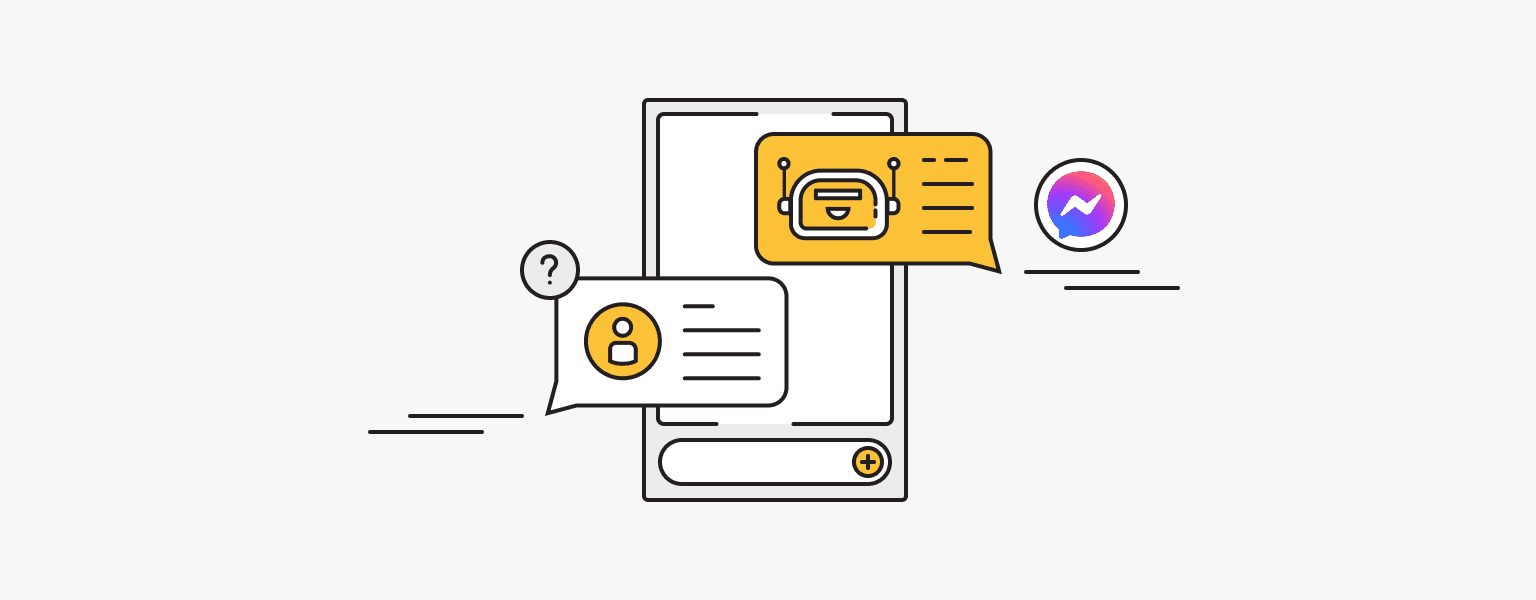
From a customer's perspective, a chatbot for Facebook Messenger is an invaluable assistant. It responds to their queries promptly, eliminating the need to search for information on your website, navigate to the FAQ section, find a specific question, and finally get an answer.
In addition, the chatbot saves you time. It efficiently handles queries you would otherwise have to answer if bots weren't available. It can cleverly guide customers through a product catalog or provide them with necessary contact information, such as a phone number or address.
The FB Messenger Platform
The Messenger platform offers various solutions and functionality to enhance customer engagement strategies.
Messenger is a robust platform for organizing efficient and responsive customer support. It provides companies with the tools and guidance to improve customer experience.
Companies can effectively engage and connect with potential customers through this platform through their preferred messaging channel. This feature optimizes the engagement of potential customers and facilitates meaningful contact.
In addition to this, Messenger is a versatile e-commerce platform. It allows companies to showcase their product catalog, process payments, and conduct transactions within the Messenger ecosystem.
With Messenger, companies can provide several account-related services such as content development, login button customization, and API integration for account linking.
With the Chat Plugin, companies can initiate conversations on their website and seamlessly continue them in the Messenger platform.
Messenger provides the ability to use ready-made survey templates such as CSAT, NPS, and CES to collect valuable customer feedback. To do so, you must select the desired survey type, create a catalog using Generic Template and integrate the Customer Feedback Template API to send surveys.
With the Messenger platform, companies can automate responses to frequently asked questions. This includes integrating a knowledge base, designing user experiences using messaging components, and applying templates such as Generic Template, Quick Replies, and NLP.
By integrating Messenger with agent software, companies can easily combine automated and personalized experiences. This process involves designing interaction flows and integrating the Messenger protocol with live agent software.
Messenger enables re-engagement with customers beyond the standard messaging window. Businesses can choose from various customer re-engagement tools, including message tags, one-time notifications (beta), and sponsored messages, to tailor their re-engagement strategies.
For more information about Facebook Messenger, visit Meta's official website.
Creating a Facebook App for Messenger
The Facebook App is a powerful tool for expanding your online presence, engaging your audience, and increasing brand awareness. This app has several features and benefits that can enhance your social media marketing efforts and contribute to the success of your business or company on this platform.
To create a Facebook App, you need to follow the steps below:
- Go to developers.facebook.com in your browser and log in to your Facebook account. Click New App to create a new app.

- Add your app name and required contact information, and click Create App.
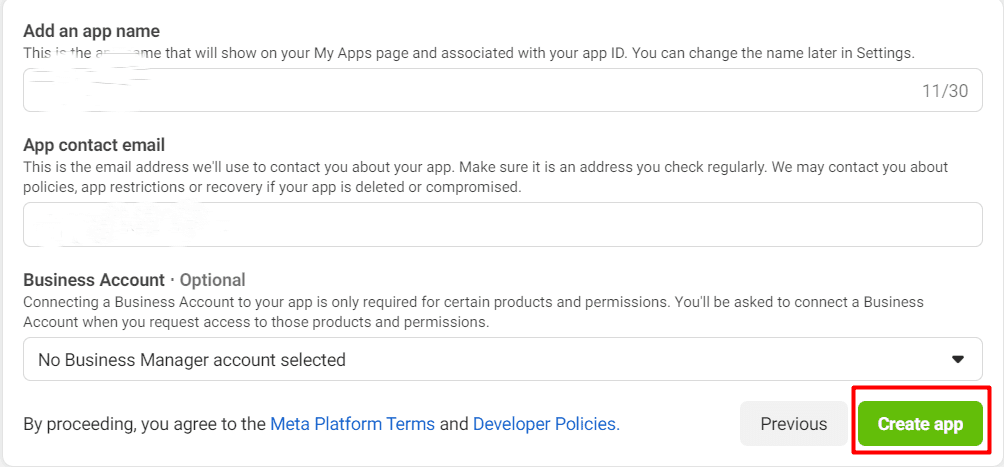
- Under Products, select Messenger and click Set Up.

- In Messenger settings, select Acess Tokens and add or create the Facebook page you will use.

- Before proceeding to the next steps, you must follow the instructions to set up Facebook's Webhook to generate the verification token you will need to complete the Messenger installation. To set up webhooks, make sure you have Node.js installed on your computer.
- In the Webhooks section, click on the Set Up Webhooks button. Then, enter the page URL in the Callback URL field and the verification token created in the previous step in the Verify Token field.
- Select the checkboxes next to the Webhook events you want to receive on your Webhook. Facebook recommends selecting at least "messages" and "messaging_postbacks."
- Then click Verify and Save. A GET request will be sent to your Webhook. If you've configured everything correctly, the settings will be automatically saved.
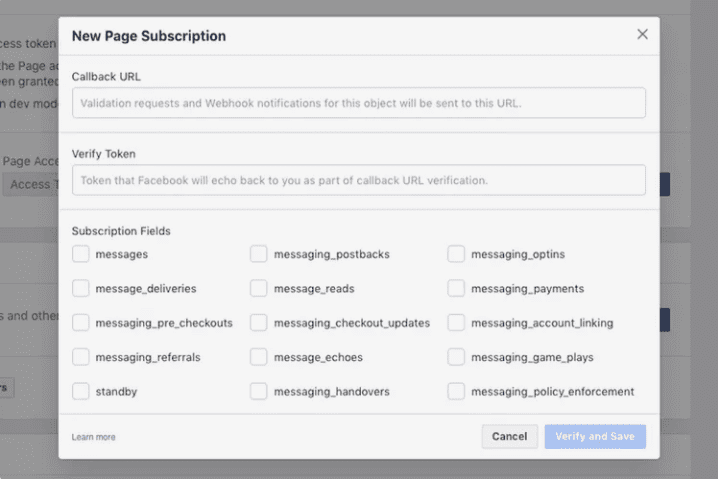
- To link your app to the page, return to App Settings. Go to Token Generation and select your page from the drop-down list. Then, in the Webhooks section, follow the same steps. Click on Select a Page and select your page from the drop-down list. After that, click Subscribe.

To ensure you're set up correctly, go to Facebook.com or use the Messenger app on your mobile device. Send a message to your page. If your Webhook successfully receives the event, your app is configured correctly.
Chatbots for Other Messengers

Creating a chatbot for messengers usually involves several steps, including setting up a development environment, designing a dialogue flow, and integrating with APIs.
Viber: Steps to Integrate a Chatbot
- To create a Viber chatbot, you need to have a Viber account. If you don't already have one, download the Viber app and register an account.
- You will need a development environment to create and test the chatbot. You can use a programming language of your choice (Python, Node.js, etc.) and a server to host the code of your bot. Popular frameworks like Flask or Express.js can come in handy here.
- Viber offers an API to interact with the platform—Study Viber's API documentation.
- To run a chatbot in Viber, you must create a public account. Follow the steps on the Viber Public Accounts page to create an account.
- Plan your conversation with the chatbot. Determine how it will react to the user's input and what actions it can perform. You can use a flowchart or diagram to visualize the conversation.
- Write the chatbot code using the Viber API. Your bot should be able to receive messages from users, process them, and send responses. It will also need to perform user authentication and data storage if necessary.
- You need to integrate your chatbot with the Viber API to make it available in Viber. This is usually done by setting up a webhook that logs incoming messages and sends replies using the Viber API.
Line: Building and Deploying Bots
- Create a Line developer account. Go to the Line developer console. Log in with your Line account or create one if you don't have one.
- Create a new provider. Click My Providers and create a new provider for your chatbot.
- Create a messaging channel. Inside the provider, click Create New Channel. Select Messaging API as the channel type. Fill in the necessary information about your chatbot, such as its name and description. Once the channel is created, you will receive a channel ID and a channel secret. Keep these credentials safe; you will need them to interact with Line Messaging API.
- Configure the channel settings. Set the Webhook URL. This is the endpoint through which Line will send incoming messages to your chat bot's server. You must host a server that will listen to these incoming requests. Configure other parameters and set the range of allowed IP addresses for incoming requests.
- Create the chatbot. To develop a chatbot, you need to use a programming language that can handle HTTP requests. Popular options include Node.js, Python, and Java. Use the Line Messaging API SDK for your chosen programming language to simplify interaction with the Line platform. Implement message handling, user authentication, and other features your chatbot needs.
- Test your chatbot. Use the Line Developers Console to test your chatbot by sending it messages and events. Use the Verify feature to make sure your webhook endpoint is configured correctly.
- Deploying the chatbot. Deploy the chatbot server on a public server or cloud platform. Ensure that it can accept incoming requests from Line servers.
WeChat: Navigating the WeChat Developer Platform
First, you must decide whether to create an official WeChat account or a mini-programme. Depending on your choice, the process will be slightly different.
- Log in to the WeChat Official Developer Platform with your WeChat account, or create one if you don't have one.
- If you create an official account, you may need to provide additional information and go through a verification process depending on the type of account you want to create (e.g., subscription, service, or corporate account).
- Follow the platform's instructions to create an official account or mini-programme.
- You must create a development environment for mini-programs using tools such as WeChat DevTools.
- Download and install WeChat DevTools, an integrated development environment (IDE) for creating and testing mini-programmes.
- Connect your WeChat developer account to WeChat DevTools to upload and test your mini-program.
- Set up your official account or mini-program profile, including profile image, name, description, and other required information. Customize your account settings, such as the chat menu, automatic replies, and message templates.
- Use WeChat DevTools to develop and test your mini-program. You can write code using HTML5, JavaScript, and CSS and see how it displays and functions in the WeChat environment.
- If your mini-program or official account requires access to certain WeChat APIs (e.g. user information, location, payments), you will need to set up the necessary permissions and API access.
- If you develop a mini-program and want to publish it to the WeChat ecosystem, you must submit it for review and approval. WeChat will review your mini-program to ensure that it complies with its rules.
- Once your mini-program or official account is approved and ready, you can launch it on the WeChat platform
The Present and Future of Chatbots: Challenges and Solutions

One of the biggest challenges in developing chatbots is understanding the intricacies of different messaging platforms. Each platform, be it Facebook Messenger, WhatsApp, or Slack, has unique rules, regulations, and technical limitations. This diversity requires chatbot developers to adapt to the specifics of a particular platform.
For example, many messengers set limits on API speed, which can limit the frequency and volume of chatbot interaction with users. This limitation can be particularly problematic during peak hours with increased user traffic, leading to slower response times.
In addition, a chatbot's user interface and functionality may be affected by platform limitations. Some messengers may impose character limits or not support multimedia content, limiting the range of interactions and services a chatbot can offer.
The globalization of business means that chatbots must offer support in multiple languages. However, there are several challenges in providing adequate multilingual support.
First of all, developing multilingual chatbots requires extensive language resources. This includes translation and localization of content and ongoing maintenance of language materials.
Another challenge concerns the peculiarities of natural language processing (NLP) in different languages. NLP models and algorithms can work differently in different languages due to grammar, syntax, and cultural context differences. This requires developers to fine-tune the NLP capabilities of the chatbot for each supported language.
Real-time interaction is a hallmark of effective chatbots, but achieving proper real-time responsiveness is challenging.
A significant problem in real-time interaction is latency. This can depend on various factors, including server response time, the complexity of the chatbot logic, and network conditions. To ensure fast responses, developers must optimize the infrastructure and minimize processing delays.
Another critical aspect of real-time performance is parallelism. Chatbots must be able to handle multiple simultaneous user interactions without sacrificing performance. Scaling the system architecture to accommodate peak demand is necessary to maintain performance during periods of high user traffic.
In scenarios where real-time access to external data sources is required, ensuring data accuracy and freshness becomes a priority. For example, financial chatbots providing stock market information must provide up-to-date data in real time.
To address these challenges, developers can employ various strategies, including performance optimization, efficient backup mechanisms, and thorough load testing to evaluate chatbot performance under various conditions.
VPS
Choose the suitable configuration and enjoy all the benefits of a virtual private server.
From $4.99/moPersonal VPN
Stay anonymous online with a dedicated IP and don't endanger your personal data.
Get $5.00/mo